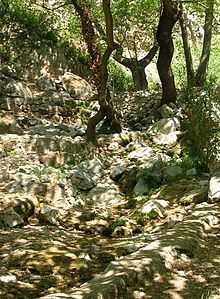Castalian Spring

The Castalian Spring, in the ravine between the Phaedriades at Delphi, is where all visitors to Delphi — the contestants in the Pythian Games, and especially suppliants who came to consult the Delphic Oracle — stopped to wash their hair; and where Roman poets came to receive poetic inspiration. This is also where Apollo killed the monster, Python, and that is why it was considered to be sacred.
Two fountains, which were fed by the sacred spring, still survive. The archaic 6th century BCE fountain house has a marble-lined basin surrounded by benches. There is also a Hellenistic or Roman fountain with niches hollowed in the rock to receive votive gifts. The Castalian Spring itself predates classical Delphi. The ancient guardian of the spring was the serpent Python, which was killed by Apollo in its lair beside the spring.
This spring in a ravine once provided drinking and washing water for the priestesses who pronounced the oracles here. The spectres of three women are said to sometimes wander the area, which is now closed off to visitors - supposedly because of falling rocks. However, a channel filled with water running from the spring comes out to the pathway.
Other uses
The Castalian Spring became a type for a well of poetic inspiration, partly by confusing it with the Spring of Pieris. The Castalian Band, a group of poets or makars associated with the Court of James VI of Scotland (including the king himself) drew their name from this source.
There is a town named Castalian Springs in Tennessee. A natural spring in this location was a gathering place for animals. Isaac Bledsoe discovered the spring in 1772. Having built a fort in 1783, Bledsoe, his brother, and their families settled near the spring in 1787. Indians killed the two brothers, who are now buried 500 yards northwest of the spring. Consequently, this area was known locally as Bledsoe's Lick. In 1828, a log inn was built, providing guests with "healthy" drinking water and mineral baths. Almost ten years later when the post office was built, the community changed its name from Bledsoe's Lick to Castalian Springs. During this period of time in history, there was a reawakening of interest in classical Greece and Rome.
In Castalia, Ohio, named after the famed site, the Blue Hole limestone configurations were tourist attractions for many years and are now fish hatcheries. Waters in the blue holes are of a constant temperature and never freeze over despite northern Ohio's cold temperatures. The water which averages 30,000 gallons an hour was first used to supply a local mill.
Castalian Springs was the name of a now-abandoned spa near Durant, Mississippi.[1]
References
- ↑ Miller, Mary Carol, Mary Rose Carter, and Greg Iles, Must See Mississippi: 50 Favorite Places. Univ. Press of Mississippi. 155-158.
External links
Coordinates: 38°28′59″N 22°30′20″E / 38.4830555556°N 22.5055555556°E